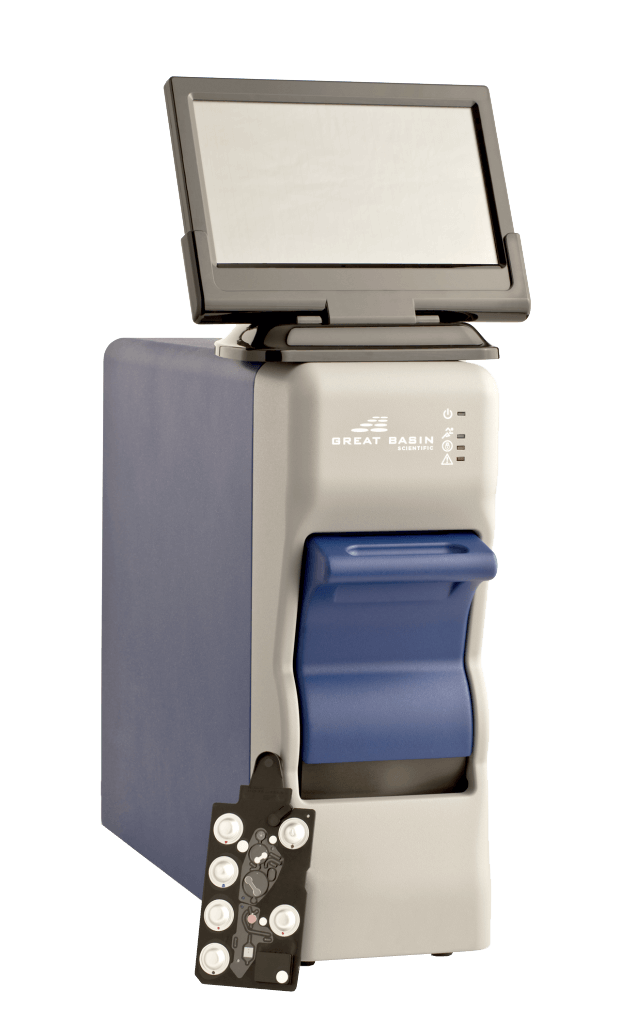The Great Basin Shiga Toxin Direct Test is a sample-to-result, automated, assay that detects Shiga toxin-producing E. coli directly from a patient’s stool sample. The assay detects stx1and stx2, in addition to identifying the hypervirulent serotype O157. Unlike competing tests on the market, this assay does not require an enrichment step.
Need for Testing
According to a report published by the Centers for Disease Control (CDC), National Enteric Disease Surveillance: STEC Surveillance Overview, Shiga toxin-producing E. coli (STEC) also known as enterohemorrhagic E. coli (EHEC) or verocytotoxigenic E. coli (VTEC), causes 265,000 illnesses each year in the United States, with more than 3,600 hospitalizations and 30 deaths. STEC symptoms vary for each person but often include severe stomach cramps, diarrhea (often bloody), and vomiting. Some infections are very mild, but others are severe or even life threatening. The majority of STEC infections in the U.S. are caused by E. coli O157:H7 (~ 36%). The CDC estimates that 2-3% of patients infected by E. coli O157:H7 develop a life-threatening condition called hemolytic uremic syndrome (HUS) which is characterized by hemolytic anemia and renal failure. Most persons with HUS recover within a few weeks, but some suffer permanent damage or die. STEC infections effect people of all ages however, the elderly, children (<5yrs) and immunocompromised patients are at a higher risk of developing severe illness. Prompt and accurate diagnosis is crucial because it may reduce the extent of kidney damage in these patients. Antibiotic therapy in STEC patients may result in more severe disease making early detection important to ensure proper treatment.
Advantage of the Great Basin’s Shiga Toxin Direct Assay over conventional culture methodology
Conventional EIA or culture-based testing for STEC is laborious, slow, and offers significantly lower sensitivity than molecular methods. The Great Basin Shiga Toxin Direct Test uses molecular methods to detect the Shiga toxin genes (stx1 and stx2), in addition to the genetic O157-specific marker. By providing definite diagnostic results in a faster timeframe – about 90 minutes vs. several hours for EIA or days for culture – physicians can make timely therapeutic and potentially life-saving patient management decisions.
The Great Basin System
Great Basin’s System employs an integrated disposable cartridge containing all necessary reagents, and a bench-top analyzer that executes the assay, interprets the results and provides electronic output to the clinician.
• True sample-to-result with about one minute of hands-on time
• On-demand testing; no batching of tests that delay results
Shiga Toxin Direct Test sample-to-result assay
- Detects Shiga toxin 1 (stx1) and Shiga toxin 2 (stx2) producing E. coli directly from a patients stool sample with no enrichment step
- Makes a definitive identification of STEC by targeting the stx1 and stx2 genes
- Identifies the O157 serotype (if Shiga toxin is detected)
- Actionable results: ensures that the physicians gets accurate diagnostic results in a fast timeframe, allowing them to make timely therapeutic and patient management decisions
Want more information?
- Shiga Toxin Direct Test Data Sheet
- View the Workflow for our Enteric Assays (Shiga Toxin Direct Test and Stool Bacterial Pathogens Panel)
For more information on the Great Basin Shiga Toxin Direct Test, or to purchase our system, please contact us.


